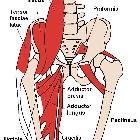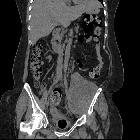Psoas major muscle




The psoas major muscle (usually shortened to just the psoas muscle) is one of the muscles of the posterior abdominal wall and lies not in the retroperitoneum but posterior to it, in the iliopsoas compartment.
Summary
- origin: vertebral bodies, intervertebral discs and transverse processes of T12 to L5
- insertion: lesser trochanter of the femur
- innervation: branches of the L1-L3 roots of the lumbar plexus
- arterial supply: lumbar arteries, iliolumbar artery, deep circumflex iliac artery, external iliac artery, femoral artery
- action: lateral flexion of the trunk; stabilizer and flexor of the hip
Terminology
The correct terminology is psoas major muscle (as opposed to just psoas muscle) to differentiate it from the psoas minor muscle.
Gross anatomy
The psoas major muscle lies in the gutter between the bodies and transverse processes of the lumbar vertebrae. Its vertebral attachment is to T12-L4 intervertebral discs, the adjacent vertebral bodies and to fibrous arches that span the concavities of the sides of the upper four vertebral bodies (superficial part). Thus there is one continuous attachment from the lower border of T12 to the upper border of L5. It also attaches to the medial ends of the transverse processes of L1 to L5 (deep part). It fuses with the iliacus muscle to form the iliopsoas muscle at the level of L5-S2 and passes inferiorly, deep to the inguinal ligament, to insert onto the lesser trochanter of the femur .
The lumbar plexus is embedded within the muscle and its branches emerge from it :
- anterior aspect: genitofemoral nerve
- lateral border: iliohypogastric, ilioinguinal, lateral femoral cutaneous and femoral nerves
- medial border: obturator nerve and lumbosacral trunk
The psoas muscle is enclosed by the psoas fascia and it is this that retains the pus in a psoas abscess . The psoas fascia (part of the iliac fascia) invests the surface of the muscle, attached to the vertebral bodies, fibrous arches, and the transverse processes, and extends along the pelvic brim attached to the iliopubic eminence at the margins of the muscle. The lateral edge blends with the anterior layer of the lumbar fascia (over quadratus lumborum).
The muscle comes to lie medial to and fuses with the iliacus muscle, such that inferiorly the two are often referred to together as the iliopsoas muscle .
Innervation
The psoas muscle is innervated by the lumbar plexus via branches from L1-L3 (mainly L2) .
Arterial Supply
- upper part: lumbar arteries
- middle part: iliolumbar artery (main artery to muscle), deep circumflex iliac and external iliac arteries
- lower part: branches of the femoral artery
Venous Drainage
- lumbar veins
- first and second lumbar veins to azygos system
- third and fourth to inferior vena cava
Lymphatic Drainage
- follows the lumbar vessels into cisterna chyli
Action
The action of this muscle is complex, acting to both laterally flex the lumbar spine as well as stabilize and flex the thigh . The antagonist is the gluteus maximus.
Relations
Lower abdomen:
- lumbosacral plexus embedded within the muscle
- anteriorly: genitofemoral nerve
- laterally: iliohypogastric, ilioinguinal, lateral femoral cutaneous and femoral nerves
- medially: obturator nerve and lumbosacral trunk
- posteriorly: part of the external vertebral venous plexus (in front of the transverse process), four lumbar arteries and veins pass beneath the four arches and run laterally behind the psoas accompanied by the sympathetic rami
Pelvis and lower limb:
- behind the inguinal ligament
- femoral nerve lying on the iliacus
- lateral to the contents of the femoral triangle
Lumbosacral triangle of Marcille:
- contents from medial to lateral: obturator nerve, iliolumbar artery, lumbosacral trunk, sympathetic trunk
Variant anatomy
- asymmetry of the psoas major muscle, which is usually not clinically significant
- associated with psoas minor - origin from T12 and L1 vertebrae and inserted on the arcuate line and iliopubic eminence
- accessory muscle slips – femoral nerve may or may not be split by accessory slip
History and etymology
From the Greek "psoa" meaning "loin" . The psoas muscle is referred to as the tenderloin by butchers.
Related pathology
Siehe auch:
- Psoasabszess
- das Femur
- psoas minor muscle
- arterielle Versorgung Musculus psoas
- Hämatom im Musculus psoas
und weiter:

 Assoziationen und Differentialdiagnosen zu Musculus psoas major:
Assoziationen und Differentialdiagnosen zu Musculus psoas major:



